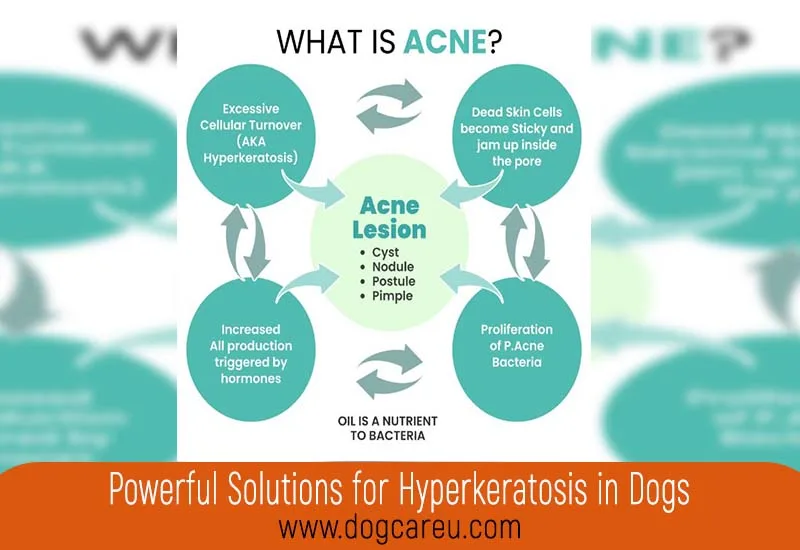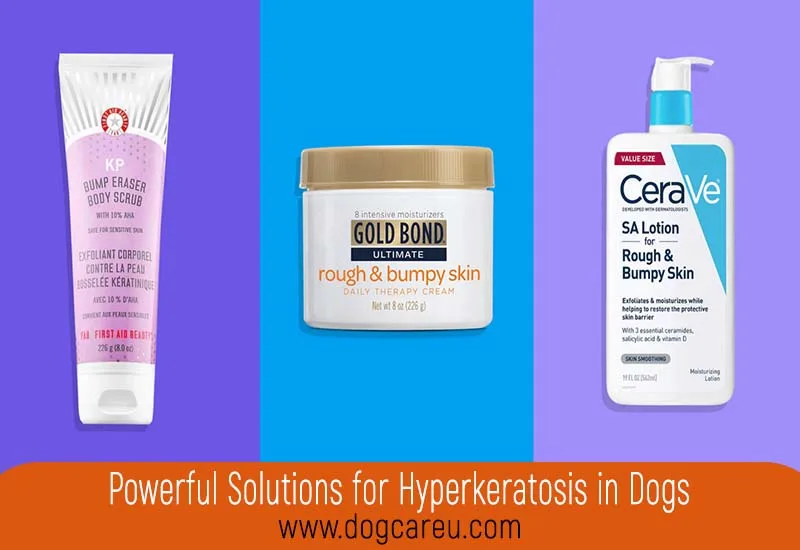Powerful Solutions for Hyperkeratosis in Dogs: The treatment for hyperkeratosis in dogs includes regular moisturizing and exfoliation of affected areas. Hyperkeratosis is a skin condition in dogs characterized by the thickening and hardening of the skin, especially on the nose, paws, and elbows.
It can be caused by various factors such as genetics, allergies, or underlying medical conditions. To alleviate the symptoms and manage hyperkeratosis, it is important to keep the affected areas moisturized with pet-safe products like balms or ointments. Regular exfoliation using gentle techniques can also help remove the excessively hardened skin.
In severe cases, veterinary intervention may be required to address any underlying causes or administer specialized treatments. Prompt and consistent care is crucial in preventing discomfort and potential complications for dogs with hyperkeratosis.
Understanding Hyperkeratosis In Dogs
What Is Hyperkeratosis?
Hyperkeratosis in dogs refers to a condition where there is excessive thickening and hardening of the skin, most commonly affecting the nose and paw pads. This condition occurs due to an overproduction of keratin, a tough protein that forms the outer layer of the skin. If left untreated, hyperkeratosis can lead to discomfort, pain, and potential complications for your furry friend.
Causes Of Hyperkeratosis
Several factors can contribute to the development of hyperkeratosis in dogs. Understanding these causes can help determine the appropriate treatment for your canine companion.
| Causes | Description |
|---|---|
| Genetic predisposition | Some dog breeds are more prone to developing hyperkeratosis due to their genetics. Breeds such as the Cairn Terrier, Irish Terrier, and Bull Terrier are commonly affected. |
| Infections or autoimmune diseases | Underlying infections, such as the canine distemper virus, or autoimmune diseases like pemphigus foliaceus can trigger hyperkeratosis in dogs. |
| Environmental factors | Exposure to harsh weather conditions, including extreme temperatures or irritants like chemicals or allergens, can contribute to the development of hyperkeratosis in dogs. |
| Malnutrition or imbalanced diet | A diet lacking essential nutrients and fatty acids can affect your dog’s skin health, potentially leading to hyperkeratosis. |
Effective Treatment For Hyperkeratosis
- Regular moisturization: Moisturizing the affected areas with specialized balms or creams helps soften the thickened skin and prevent cracks or fissures.
- Improving nutrition: Ensuring your dog’s diet is well-balanced, rich in omega-3 fatty acids, and contains essential vitamins and minerals can promote healthier skin and reduce hyperkeratosis symptoms.
- Proper paw pad care: Regularly trimming and sanding down the hardened paw pads can alleviate discomfort and prevent excessive buildup of keratin.
- Medication: In cases where hyperkeratosis is caused by an underlying infection or autoimmune disease, veterinary-prescribed medications such as antibiotics or corticosteroids may be necessary to manage the condition.
By understanding hyperkeratosis in dogs and recognizing its causes, you can take proactive steps in providing the necessary treatment and care for your beloved pet. Remember, consulting with a veterinarian for a proper diagnosis and tailored treatment plan for your dog’s hyperkeratosis is crucial for their well-being and comfort.

Identifying Hyperkeratosis In Dogs
When it comes to our furry friends, it is important to be vigilant about their health and well-being. One common condition that can affect dogs is hyperkeratosis, which is characterized by the thickening of the skin on the nose or paw pads. Identifying hyperkeratosis early on is crucial for prompt treatment and management. In this section, we will explore the symptoms and types of hyperkeratosis in dogs.
Symptoms Of Hyperkeratosis
Identifying hyperkeratosis in dogs may seem challenging at first, but being aware of the telltale signs can help you catch it early. Some common symptoms to watch out for include:
- Excessive dryness and scaling of the nose or paw pads
- Formation of crusty, raised bumps
- Thickened and roughened skin
- Discoloration of the affected area
- Difficulty walking or discomfort when pressure is applied to the paws
If you notice any of these symptoms in your dog, it is essential to consult with a veterinarian for an accurate diagnosis.
Types Of Hyperkeratosis
Hyperkeratosis in dogs can manifest in different ways, depending on the affected areas. Here are the two main types:
| Type | Description |
|---|---|
| Focal | Focal hyperkeratosis is limited to specific areas, such as the nose or certain paw pads. |
| Proliferative | Proliferative hyperkeratosis affects multiple areas, spreading to several paw pads or even covering the entire nose. |
Understanding the type of hyperkeratosis in your dog can help guide the treatment approach and ensure the most effective care.
Conventional Treatment Methods For Hyperkeratosis
Hyperkeratosis in dogs is a common condition that is characterized by the excessive and abnormal growth of keratin, a protein found in the outer layer of the skin. While there is no cure for hyperkeratosis, there are several conventional treatment methods available to manage the symptoms and improve the overall comfort of your furry friend. These treatments can be divided into three categories: topical treatments, oral medications, and surgical options. Let’s take a closer look at each of these methods.
Topical Treatments
Topical treatments are often the first line of defense when it comes to managing hyperkeratosis in dogs. These treatments are designed to soften and moisturize the affected skin, reducing the build-up of excess keratin. Here are some commonly used topical treatments:
- Paw Soaks: Soaking the affected paws in warm water with Epsom salts or gentle antiseptic solutions can help soften the thickened skin and facilitate its removal.
- Paw Balms: Applying paw balms containing ingredients like shea butter, coconut oil, or beeswax can help keep the paw pads moisturized and prevent cracking.
- Vitamin E Oil: Applying vitamin E oil topically can promote healing and soothe the discomfort associated with hyperkeratosis.
Oral Medications
In more severe cases of hyperkeratosis, oral medications may be prescribed to manage the condition. These medications work internally to address the underlying causes and symptoms of hyperkeratosis. Here are some commonly prescribed oral medications:
- Vitamin A Supplements: Vitamin A is crucial for skin health and can help regulate the abnormal keratinization process in hyperkeratotic dogs.
- Omega-3 Fatty Acids: These supplements have anti-inflammatory properties that can help reduce inflammation and improve the overall health of your dog’s skin.
- Retinoids: Retinoids, such as isotretinoin, can be prescribed to manage hyperkeratosis by inhibiting the excessive growth of keratin.
Surgical Options
In cases where topical treatments and oral medications fail to provide adequate relief, surgical intervention may be considered. Surgical options for hyperkeratosis are typically reserved for severe, chronic cases that have not responded to other forms of treatment. Surgery involves removing the excessive layers of keratinized skin, allowing for the regeneration of new, healthier skin. It’s important to consult with a veterinarian to determine whether surgery is suitable for your dog’s specific condition.
Natural Remedies And Home Treatments
Discover effective natural remedies and home treatments to address hyperkeratosis in dogs. These safe and holistic approaches offer a gentle and non-invasive way to alleviate the symptoms and promote healthy skin for your furry friend.
Moisturizing Balms And Creams
Moisturizing balms and creams can be effective natural remedies for treating hyperkeratosis in dogs. Applying a moisturizing balm or cream helps soften and hydrate the skin, reducing the dry and rough patches caused by the condition. These products are designed to provide deep hydration and nourishment to the affected areas, aiding in the restoration of healthy skin. Look for balms and creams specifically formulated for dogs, as they are free from harmful ingredients and have a pH level suitable for canine skin.
Vitamin And Mineral Supplements
Supplementing your dog’s diet with the right vitamins and minerals can further support the treatment of hyperkeratosis. Certain nutrients play a crucial role in promoting healthy skin and regulating keratin production. For example, vitamin E is known for its antioxidative properties and can help reduce inflammation and enhance skin healing. Zinc is another essential mineral that aids in proper skin function and cell regeneration. Consult with your veterinarian to determine the appropriate dosage and duration for administering these supplements to your furry friend.
Dietary Changes
Making dietary changes for your dog can have a positive impact on their skin health and alleviate the symptoms of hyperkeratosis. Including foods rich in omega-3 fatty acids, such as salmon, sardines, and flaxseed, can help reduce inflammation and itching. These fatty acids also contribute to a healthier skin barrier, preventing excessive dryness. Additionally, adding foods high in vitamins A and C, like carrots and spinach, can promote skin health and repair damaged tissue.
Remember to introduce any dietary changes gradually and monitor your dog’s response to ensure optimal results. To sum up, there are several natural remedies and home treatments that can help improve hyperkeratosis in dogs. Using moisturizing balms and creams, providing suitable vitamin and mineral supplements, and making dietary changes are all effective ways to support the healing process and restore your dog’s skin health. While these remedies can be beneficial, it is important to consult with a veterinarian before starting any treatment to ensure the best approach for your furry companion.
Alternative Therapies For Hyperkeratosis
Discover effective alternative therapies for treating hyperkeratosis in dogs. These natural remedies offer a holistic approach to alleviating the condition, promoting healthier skin and overall well-being for your beloved pet.
Acupuncture
Acupuncture is an effective alternative therapy for hyperkeratosis in dogs. This traditional Chinese medicine practice involves inserting thin needles into specific points on the body to stimulate the flow of energy.
Acupuncture can help manage hyperkeratosis symptoms by promoting blood circulation, reducing inflammation, and improving the immune system’s response. This therapy can also relieve pain and discomfort associated with the condition.
The needles used in acupuncture are typically painless and cause minimal discomfort to the dog. Many dogs find acupuncture sessions relaxing, and it can be an enjoyable experience for them.
Acupuncture sessions for hyperkeratosis may need to be repeated over time to maintain its benefits. It is best to consult a qualified veterinarian or a licensed veterinary acupuncturist to determine the appropriate duration and frequency of treatments for your dog.
Herbal Medicine
Herbal medicine is another beneficial alternative therapy for treating hyperkeratosis in dogs. It involves the use of natural herbs and plant extracts to alleviate symptoms and improve overall well-being.
Several herbs have anti-inflammatory, antiseptic, and immune-boosting properties, which can be advantageous for dogs with hyperkeratosis. Some commonly used herbs in herbal medicine for hyperkeratosis include chamomile, calendula, aloe vera, and lavender.
Herbal medicines can be administered orally or topically, depending on the specific formulation and recommendation of a professional. They can help reduce inflammation, soothe irritated skin, and promote the healing of hyperkeratotic lesions.
It is vital to consult a veterinarian experienced in herbal medicine for dogs to ensure the appropriate selection and dosage of herbs for your pet’s individual needs. The veterinarian can also monitor for any potential side effects or interactions with other medications.
Physical Therapy
Physical therapy is a valuable alternative treatment approach for hyperkeratosis in dogs. It involves various exercises, hydrotherapy, massage, and other techniques aimed at improving mobility, reducing pain, and promoting healing.
This therapy can help keep the affected areas clean and prevent them from becoming excessively dry or cracked. Physical therapy exercises and massages enhance blood circulation and promote a healthy skin turnover process.
Hydrotherapy, such as swimming or underwater treadmill exercises, can be particularly beneficial for dogs with hyperkeratosis. The buoyancy of water reduces stress on the joints and helps improve the range of motion.
A qualified veterinary physical therapist can create a tailored physical therapy plan for your dog based on their specific needs and condition. Regular physical therapy sessions can significantly enhance your dog’s physical well-being and overall quality of life.

Credit: www.amazon.com
Preventing Hyperkeratosis In Dogs
Hyperkeratosis, a condition characterized by thickening and hardening of the skin, can be uncomfortable and painful for dogs. Fortunately, there are several preventive measures that owners can take to minimize the risk and severity of this condition. By incorporating these simple steps into your dog’s routine, you can help maintain the health and well-being of their paws and prevent the development of hyperkeratosis.
Regular Grooming And Trimming Of Paw Pads
Grooming plays a crucial role in preventing hyperkeratosis in dogs. Regularly trimming the hair and nails on your dog’s paw pads is essential to maintaining their paw health. Trimming the excess hair around the pads with a pair of pet-safe scissors not only prevents dirt and debris from accumulating but also allows for better air circulation. Proper air circulation reduces moisture retention, lowering the chances of developing hyperkeratosis. Additionally, keeping the nails trimmed can prevent uneven weight distribution, reducing the risk of pressure sores and calluses.
Proper Nutrition And Hydration
Optimal nutrition and hydration are fundamental in preventing hyperkeratosis. Feeding your dog a balanced diet rich in essential fatty acids, vitamins such as A and E, and minerals can promote healthy skin and paw pad health. Ensuring an adequate intake of water is also essential, as hydration helps maintain the overall health and elasticity of the skin. A well-hydrated body is less prone to dryness and cracking, reducing the risk of developing hyperkeratosis.
Avoidance Of Harsh Environments
Protecting your dog from harsh environments is another key aspect of preventing hyperkeratosis. Exposure to extreme temperatures, rough surfaces, and chemicals can significantly irritate and damage the paw pads. Limiting your dog’s time in extreme hot or cold conditions, providing protective footwear when necessary, and avoiding walking on rough or abrasive surfaces can help minimize the risk of hyperkeratosis. Additionally, using pet-safe and chemical-free cleaning products can prevent the drying or cracking of paw pads.
Incorporating these preventive measures into your dog’s daily routine can go a long way in maintaining their paw health and preventing the development of hyperkeratosis. By prioritizing regular grooming, ensuring proper nutrition and hydration, as well as avoiding harsh environments, you can help your furry friend stay comfortable and keep their paws healthy and problem-free.

Conclusion
The treatment for hyperkeratosis in dogs involves a combination of medical management and regular grooming. Maintaining a proper skincare routine, using moisturizers, and protecting the paws from further damage are important aspects of the treatment plan. It is essential to consult a veterinarian for a proper diagnosis and personalized treatment options.
By following these steps, you can help improve your dog’s quality of life and manage the symptoms of hyperkeratosis effectively.


